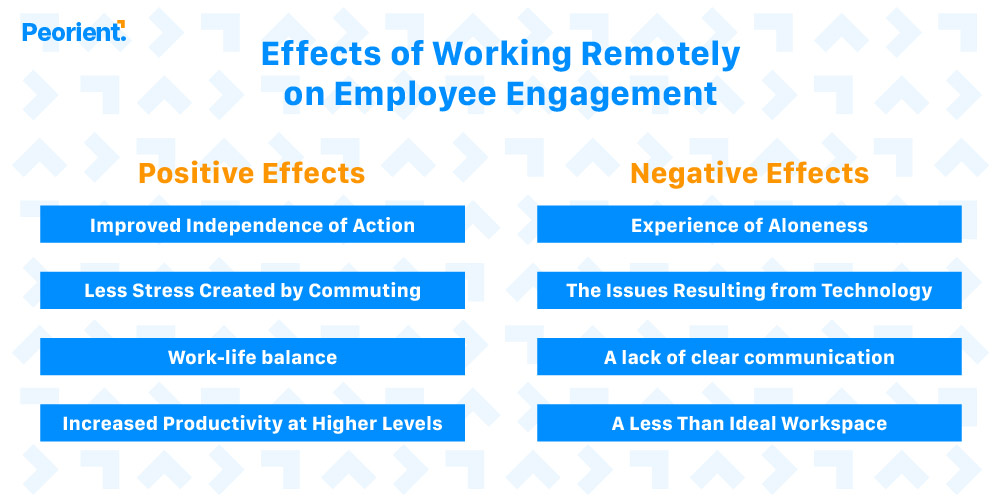The involvement of remote workers has grown in significance for companies and human resources departments as hybrid and remote work environments are more common. Developing new approaches will help engage remote workers, who present unique challenges, preserving and strengthening their link to the firm’s goal and the team dynamics. This paper aims to provide a thorough analysis and strategies that may be used to increase employee engagement in distant locations effectively.
Getting Oneself Comfortable with the Idea of Remote Workers
The degree to which people working remotely have a strong emotional connection to their company, are committed to their work, and provide extra effort to help the company grow is known as “remote employee engagement.” Remote employee engagement offers different challenges in contrast to normal in-office employee engagement, and its related problems are due to physical separation and the lack of spontaneous connections. Human resources teams have to create strategies that fit these particular issues in order to build a remote workforce that is committed and engaged.
The Effects of Working Remotely on Employee Engagement

Positive Effects
- Improved Independence of Action
Working from home gives employees more control over their work schedules and processes, which eventually helps to raise job satisfaction and employment involvement. Giving employees the chance to choose when, where, and how they work can help them feel much more autonomous.
– Actions
1. Workers should be free to choose their working schedules if it makes sense.
2. One must bring the required equipment and supplies for working from anywhere.
3. Encouragement of individuals to choose the work style most suited for them is crucial.
- Less Stress Created by Commuting
Lack of frequent commutes might help to enhance mental health as well as balance between job and personal life. Better degrees of employee engagement result from the time workers save by not having to travel being spent toward either personal or professional growth.
– Actions
1. Emphasizing the benefits of a shorter commute for materials used in recruitment and onboarding is crucial.
2. Encourage your employees to use their free time for hobbies like skill development or self-care.
3. More ideal work-life balance
- Work-life balance
Working from home lets employees better control the tensions between their personal and business lives. Maintaining this balance might increase overall well-being and job satisfaction, raising engagement.
– Actions
1. Establish policies that let the staff be flexible and consider personal obligations.
2. Encourage work-life balance management through time management seminars, among other resources.
- Increased Productivity at Higher Levels
Many people who work from home say that reduced distractions in the office and the freedom to create a perfect working environment fit their personal needs and help increase their productivity.
– Actions
1. Please provide some ideas on how to create a somewhat effective home office.
2. Using productivity tools and technologies helps your employees stay on target.
Negative Consequences
- Experience of Aloneness
Work done from a distance might cause one to feel detached from the team and the company and alone. If employees have regular face-to-face meetings, they may feel safe, which positively affects their degree of participation.
– Actions
1. Ensure the virtual team has regular social events and meetings booked.
2. Encouragement of managers and staff members to plan frequent check-ins is crucial.
- The Issues Resulting from Technology
Many elements might affect productivity and morale, including but not limited to inadequate IT support, poor internet connectivity, and ignorance of the technology used for remote work.
– Actions
1. Provide consistent tools and assistance for information technology.
2. Training courses should teach how to utilize technology for remote work effectively.
- A lack of clear communication
Remote work environments might lead to communication failures that could cause misunderstandings and a lack of clarity on responsibilities and expectations.
– Actions
1. Apply easily comprehensible communication protocols and channels.
- Check that there are feedback loops and regular updates among team members.
- A Less Than Ideal Workspace
Some employees may need easy access to a suitable and pleasant home office environment. If they have to work in cramped or shared spaces, their degree of comfort and output might drop.
– Actions
1. Allowances or stipends should cover the purchase of home office equipment.
2. Talk about methods that have been effective in creating a remote workspace.
Approaches for Employee Participation from a Remote Location
Create a Strong and Consistent Remote Onboarding Experience
A well-organized remote onboarding program is essential to building the foundation for a good employee engagement experience. One of the best brands to follow this practice with a good onboarding process is Remunance; here is a checklist of what their founder mentioned are the must-haves for good onboarding:
- Clear lines of communication and frequent check-ins are crucial in ensuring that newly recruited staff members remain engaged and well-informed. These practices help to build a sense of connection and understanding, which is particularly important in a remote work setting.
- An introduction to the principles and culture of the company aimed at helping new employees to be involved right from the start.
- Training on the tools and methods for practical remote work can guarantee that newly employed staff members are sufficiently ready to fulfill their duties.
These changes allow recently recruited staff members to interact with other team members and build relationships with them.
Actions:
- Create an extensive checklist covering all the most crucial aspects of the recruit experience for remote workers undergoing onboarding.
- Urge organizations to design their own ‘first day traditions’ to honor recently recruited staff members. These traditions can range from a welcome breakfast to a personalized welcome kit, fostering a sense of belonging and appreciation among new employees.
- Regularly sought feedback from recently recruited staff members will help to enhance the remote onboarding process.
Allowance for distant location working
Offering a remote work allowance is a tangible way to show that the company is committed to supporting its geographically dispersed employees. This financial assistance can be used for various purposes, all aimed at enhancing the remote work experience and ensuring employee comfort and productivity.
- Ergonomic office furniture is crucial to guarantee employees have comfortable and health-conscious workspaces.
- A fast internet connection allows one to run remotely efficiently and flawlessly.
- Providing the tools required for such people to execute their tasks effectively depends on both hardware and software.
Actions
- Research the local rules and regulations about work-from-home allowances.
- Create a home office guide with information on ergonomics, tools, and brain breaks to help employees set up a nice workspace.
The creation of a buddy system for fresh graduates

Using a buddy system—matching recently recruited employees with more seasoned colleagues—helps smooth the transition into the organization.
This system provides:
- Giving fresh employees direction and encouragement can help them to negotiate their roles and responsibilities.
- Social contact aims to reduce sentiments of isolation through connection development.
- Helping recently recruited workers to become more efficient in less time.
Actions
- Start by testing the buddy system within one department of the company.
- Kindly provide a document detailing the buddy program’s operations and include a checklist of tasks required of the pals.
- Building Exceptional Remote Location Managers
The power of management in maintaining a healthy remote work environment
Managers need to possess skills and strategies that specifically cater to the needs of remote workers to ensure their engagement, productivity, and satisfaction. Clear and regular communication will help guarantee that every team member is always informed and on the same page.
- Delegating duties and trusting the team helps employees to become owners of their work.
- Get to know the challenges that coworkers are experiencing and provide help when needed to show empathy.
- Regular comments and appreciation help keep staff aware of their job and drive intact.
Actions
- Give managers the chance to engage in remotely-based leadership development workshops.
- Create peer networks among managers so they may share their backgrounds and provide guidance.
- Establish a private line of contact for managers so they may share their insights and celebrate their achievements.
Keep open channels of contact and define your expectations precisely.
Working remotely calls for good communication and clearly defined expectations. Implement:
- 30–60–90 Day Plans: Giving new hires direction and organization will help them to be ready for success upon starting their work.
- Regular check-ins help one to keep constant alignment and quickly solve any issues.
Actions:
- Create thorough instructions and templates for projects spanning thirty to sixty to ninety-day periods.
- Ensure managers get instruction in successful communication techniques for use in remote locations.
Promote inclusiveness in the workplace.
Giving employees greater autonomy correlates with higher degrees of motivation and involvement. Those groups must:
- Clarify what autonomy looks like within the company’s context and how it relates to the business’s goals.
- Encourage managers to include their staff in decisions directly related to autonomy and decisions about independence.
- Regular surveys or feedback sessions in which employees are questioned about their experiences with autonomy help one gather employee comments.
Actions:
- Establish and provide a clear framework for staff members’ autonomy in the workplace. This should be done often to find out how content workers are with their degree of independence.
Enhancement of Distributed Employees’ Experience
One needs the following for a remote worker to have a good experience:
- One may ensure a comprehensive and fascinating onboarding process using remote preboarding and onboarding.
- Updated equipment is the supply of functional and current hardware and software to staff personnel.
- “Collaboration tools” for straightforward communication and teamwork tools to preserve team ties using readily available technologies.
- Close-knit teams concentrate on helping strong team chemistry and effective remote management strategies to grow.
- Maintaining a collection of items for remote workers who could be accessible by staff members whenever needed will help ensure accessibility.
Actions:
- Establish a guidebook for the employee experience that outlines the critical components of a remarkable experience for remote workers.
- Starting with the onboarding process and extending through ongoing development, ensure your strategy covers every phase of the employee’s life.
Value and thank staff members who work remotely.
One practical approach to raising staff members’ level of involvement is rewarding them. Simple thanks for expressing that you have a lot of power. These are many tactics:
- Encouragement of team members to recognize and value one another’s efforts comes from peer-to-peer appreciation.
- Managerial acknowledgment is the habit of managers frequently appreciating the work of their staff.
- Formal acknowledgment programs are those established to honor achievements and notable milestones.
Actions:
- Create a channel on a network like Slack dedicated just for recognition.
- Managers should be taught the need to give regular gratitude.
- Workers should be able to comment on the effectiveness of the recognition events.
Build coherent and present teams.
Working remotely calls for a deliberate attempt to build solid and coherent teams. Here are some techniques:
- One virtual team-building exercise is regular participation in virtual activities to foster team spirit.
- Encouragement of casual catch-ups and chats unrelated to business belongs to informal encounters.
- Using technologies that provide seamless communication and cooperation helps to promote teamwork, using which one may assist.
Actions:
- Make sure virtual team meetings and social gatherings are booked often.
- While working in a team, try many gamification strategies.
- To build personal ties, make it a practice to meet in person regularly.
Create a toolkit for those working remotely.
Storing resources centrally ensures that distant workers have access to the data they need to perform their tasks effectively.
This library should have included the following:
- Home office design recommendations guide how to design a workstation that is both ergonomic and efficient.
- Part of the health and wellness material includes advice on having an excellent work-life balance and mental health.
- The IT assistance and troubleshooting section offers specifics on resolving common technical issues.
- The HR and Policy Information clearly and briefly outlines the company’s policies and procedures.
Actions:
- Ask recently hired employees which tools they felt most helpful and which they did not find useful.
- To help people understand challenging ideas, provide short yet fascinating films.
- Regular library updates with fresh resources and encouraging staff members to participate should ensure this.
Encouragement of employee decision-making involvement is vital.
Giving employees chances to participate in decision-making procedures helps them to develop their sense of responsibility and involvement. Strategies consist of the following:
- Suggestion programs relate to systems enabling employees to provide comments and ideas.
- One example of co-defining goals and key performance indicators (KPIs) is working with employees to set their objectives.
- Inviting employees to form rules and policies for the company is known as policy engagement.
Actions
- Guide managers in including their staff members in the corporate decision-making process.
- Establish a system wherein staff members may offer ideas and actively encourage program involvement.
- Review and answer often the employee feedback you provide.
Create Learning and Professional Development Prospectives
Retaining employee engagement depends on giving remote employees opportunities for learning and development. These are some possibilities:
- Online training programs include seminars and courses on topics relevant to the area, covering disciplines and abilities.
- Utilizing relationships between mentors and mentees, mentoring programs are meant to help the knowledge to be transmitted.
- Work with employees to create customized development programs that fit their career goals. We call them personal development plans.
Actions
- The gathering of resources for remote work should include a part of learning and growth.
- One should consider using micro-mentoring programs to aim for targeted skill development.
- Managers should be urged during regular check-ins to talk with their staff about development goals.
Plan In-Person Get-Togethers That Will Not Be Forgotten
Periodic in-person activities can significantly boost distant workers’ involvement as personal links grow and team cohesion rises. Think about:
- Annual or bi-year company-wide events gather employees who work remotely for a few days so that strategic conversations and team-building activities may occur.
- Organizing more frequent team-level get-togethers helps maintain close-knit ties through meetings that are more personal and relevant to the team.
Actions
- Motivational leaders should inspire managers to engage their employees in in-person events regularly.
- Verify the proper communication of the expectations and the event budget.
- At least one major corporate-wide event should be scheduled annually if we want to raise attendance and involvement.
Best Practices for Employee Engagement in Remote Work Settings
- Make sure that projects for remote involvement are part of the whole corporate and human resources strategy so that you can match with the company plan.
- Regularly acquired input from distant workers via pulse surveys should be sought for and acted upon; plans should be changed suitably.
- Ensure candidates are a good fit for the distant location before choosing them. This may be achieved by eloquently presenting the reality of working remotely throughout the recruiting process.
- Keeping remote employees informed and mainly engaged depends on keeping open lines of contact on business goals, advancements, and expectations. Encouragement of openness is one approach to do this.
Conclusion
Establishing a working environment that promotes the involvement of remote workers depends on using a thorough approach. Following the ideas in this guidebook will help businesses enhance their remote staff’s connection, commitment, and general participation. These projects will not only raise employee satisfaction and productivity but also help the firm be effective and resilient in the long term strengthening it.







